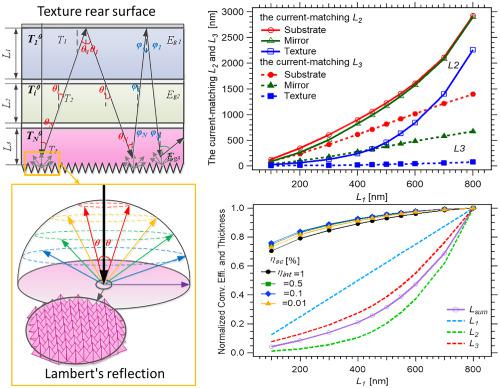当前位置:
X-MOL 学术
›
Prog. Photovoltaics
›
论文详情
Our official English website, www.x-mol.net, welcomes your
feedback! (Note: you will need to create a separate account there.)
Modeling and design for low‐cost multijunction solar cell via light‐trapping rear texture technique: Applied in InGaP/GaAs/InGaAs triple junction
Progress in Photovoltaics ( IF 8.0 ) Pub Date : 2019-12-19 , DOI: 10.1002/pip.3217 Lin Zhu 1, 2 , Yuji Hazama 2, 3 , Anurag Reddy 4 , Kentaroh Watanabe 4 , Yoshiaki Nakano 4 , Masakazu Sugiyama 4 , Hidefumi Akiyama 2, 3
Progress in Photovoltaics ( IF 8.0 ) Pub Date : 2019-12-19 , DOI: 10.1002/pip.3217 Lin Zhu 1, 2 , Yuji Hazama 2, 3 , Anurag Reddy 4 , Kentaroh Watanabe 4 , Yoshiaki Nakano 4 , Masakazu Sugiyama 4 , Hidefumi Akiyama 2, 3
Affiliation

|
To realize high efficiency in parallel with low cost, a light‐trapping rear texture was proposed to be implemented in substrate‐free thin‐film multijunction (MJ) cells. A detailed‐balance theory was formulated taking account of the finite light absorption in thin subcells. Such presented absorption model is general and useful to optimize the subcell thickness for MJ solar cells with light‐trapping design. It is applied for InGaP/GaAs/InGaAs triple‐junction solar cells to simulate subcell photocurrents and to obtain the current‐matching (minimum requisite) subcell thicknesses combinations. Furthermore, the detailed‐balance conversion efficiency was estimated for both radiative limit and the cases with below‐unity internal radiative efficiency. For InGaP/GaAs/InGaAs MJ cells with InGaP subcell thickness less than 600 nm, adding a random‐textured rear reflector can enhance light absorption so significantly that over 90% of InGaAs‐cell thickness and even 50% of GaAs‐cell thickness would be cut without any penalty in conversion efficiency, compared with the subcell thicknesses in traditional MJ cells with flat rear reflectors. Additionally, the thickness combination, (InGaP, GaAs, and InGaAs) = (450 nm, 333 nm, and 26 nm), is recommended to achieve both high conversion efficiency and low material cost. This work provides a very important theoretical guidance for the development on low‐cost and high‐efficiency MJ devices.
中文翻译:

低成本多结太阳能电池通过陷光后纹理技术进行建模和设计:应用于InGaP / GaAs / InGaAs三重结
为了在低成本的同时实现高效率,建议在无基板的薄膜多结(MJ)单元中实现捕光后部纹理。考虑到薄子电池中有限的光吸收,制定了详细的平衡理论。提出的这种吸收模型是通用的,可用于通过陷光设计优化MJ太阳能电池的子电池厚度。它用于InGaP / GaAs / InGaAs三结太阳能电池,以模拟子电池光电流并获得电流匹配(最低要求)的子电池厚度组合。此外,估算了辐射极限和单位内部辐射效率低于零的情况下的详细平衡转换效率。对于InGaP子电池厚度小于600 nm的InGaP / GaAs / InGaAs MJ电池,与传统MJ电池的子电池厚度相比,增加随机纹理的后反射器可以显着增强光吸收,以至于InGaAs电池厚度的90%甚至GaAs电池厚度的50%都将被切割而不会降低转换效率。带有平后反光镜。此外,建议同时使用厚度组合(InGaP,GaAs和InGaAs)=(450 nm,333 nm和26 nm),以实现高转换效率和低材料成本。这项工作为开发低成本,高效率的MJ器件提供了非常重要的理论指导。与具有平后反射器的传统MJ电池的子电池厚度相比。此外,建议同时使用厚度组合(InGaP,GaAs和InGaAs)=(450 nm,333 nm和26 nm),以实现高转换效率和较低的材料成本。这项工作为开发低成本,高效率的MJ器件提供了非常重要的理论指导。与具有平后反射器的传统MJ电池的子电池厚度相比。此外,建议同时使用厚度组合(InGaP,GaAs和InGaAs)=(450 nm,333 nm和26 nm),以实现高转换效率和低材料成本。这项工作为开发低成本,高效率的MJ器件提供了非常重要的理论指导。
更新日期:2019-12-19
中文翻译:

低成本多结太阳能电池通过陷光后纹理技术进行建模和设计:应用于InGaP / GaAs / InGaAs三重结
为了在低成本的同时实现高效率,建议在无基板的薄膜多结(MJ)单元中实现捕光后部纹理。考虑到薄子电池中有限的光吸收,制定了详细的平衡理论。提出的这种吸收模型是通用的,可用于通过陷光设计优化MJ太阳能电池的子电池厚度。它用于InGaP / GaAs / InGaAs三结太阳能电池,以模拟子电池光电流并获得电流匹配(最低要求)的子电池厚度组合。此外,估算了辐射极限和单位内部辐射效率低于零的情况下的详细平衡转换效率。对于InGaP子电池厚度小于600 nm的InGaP / GaAs / InGaAs MJ电池,与传统MJ电池的子电池厚度相比,增加随机纹理的后反射器可以显着增强光吸收,以至于InGaAs电池厚度的90%甚至GaAs电池厚度的50%都将被切割而不会降低转换效率。带有平后反光镜。此外,建议同时使用厚度组合(InGaP,GaAs和InGaAs)=(450 nm,333 nm和26 nm),以实现高转换效率和低材料成本。这项工作为开发低成本,高效率的MJ器件提供了非常重要的理论指导。与具有平后反射器的传统MJ电池的子电池厚度相比。此外,建议同时使用厚度组合(InGaP,GaAs和InGaAs)=(450 nm,333 nm和26 nm),以实现高转换效率和较低的材料成本。这项工作为开发低成本,高效率的MJ器件提供了非常重要的理论指导。与具有平后反射器的传统MJ电池的子电池厚度相比。此外,建议同时使用厚度组合(InGaP,GaAs和InGaAs)=(450 nm,333 nm和26 nm),以实现高转换效率和低材料成本。这项工作为开发低成本,高效率的MJ器件提供了非常重要的理论指导。











































 京公网安备 11010802027423号
京公网安备 11010802027423号